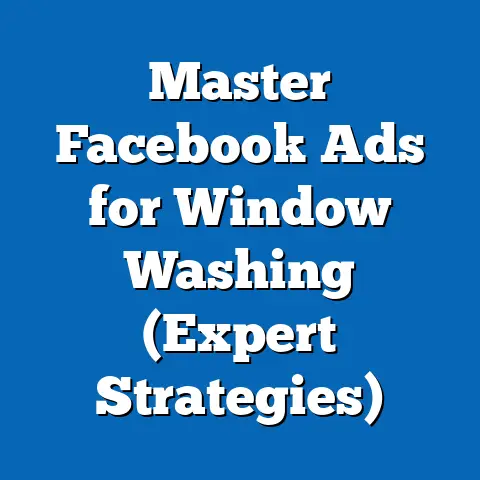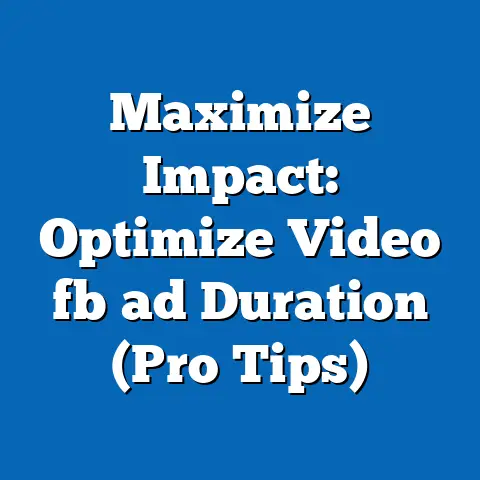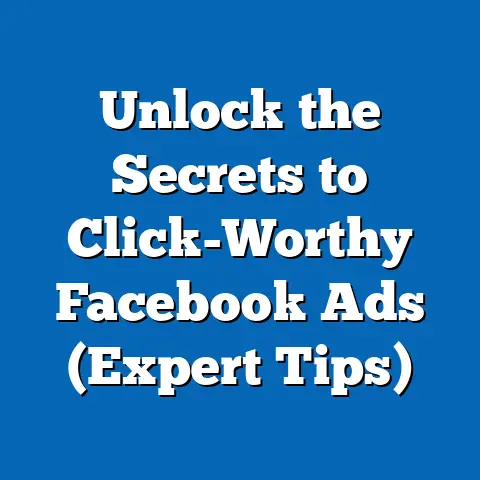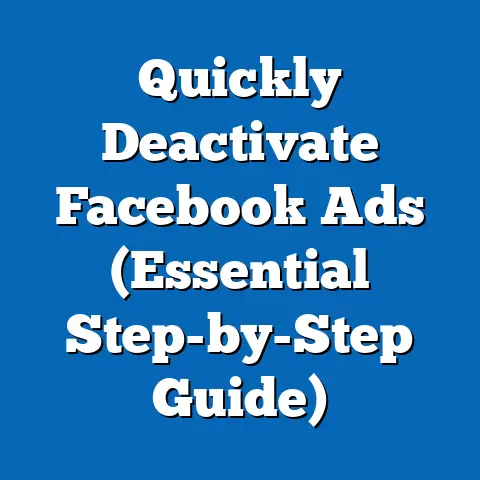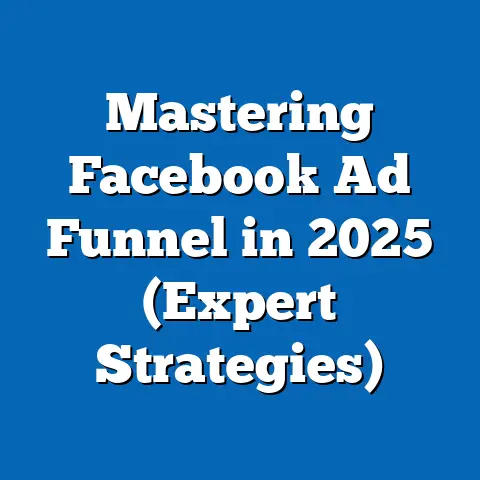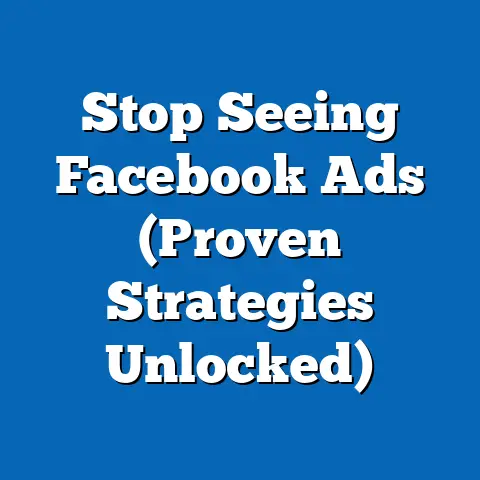Create Irresistible Facebook Banner Ads (Proven Template)
In the ever-evolving landscape of digital marketing, businesses face a pressing dilemma: how to stand out in the crowded space of social media advertising, particularly on Facebook, where users are bombarded with an average of 1,500 posts per day, according to a 2022 study by Hootsuite. Despite the platform’s massive reach—with 2.9 billion monthly active users as of Q3 2023 (Statista)—only 1.4% of Facebook ads achieve a click-through rate (CTR) above the industry benchmark of 0.9%, per WordStream’s 2023 Advertising Benchmarks Report. This stark statistic highlights the challenge of creating banner ads that not only capture attention but also drive meaningful engagement and conversions.
Section 1: The State of Facebook Advertising in 2023
A Crowded Digital Marketplace
Facebook remains a cornerstone of digital advertising, with businesses spending over $50 billion annually on the platform, as reported by eMarketer in 2023. However, the sheer volume of content—combined with algorithm changes prioritizing organic engagement—has made it increasingly difficult for ads to break through the noise. The average cost-per-click (CPC) on Facebook has risen by 17% year-over-year to $0.97, while the average CTR has stagnated at 0.9%, signaling a need for more effective creative strategies (WordStream, 2023).
Moreover, user fatigue is a growing concern. A 2022 survey by Pew Research found that 54% of Facebook users feel overwhelmed by the volume of ads, with 38% admitting to actively ignoring them. This underscores the importance of designing banner ads that are visually compelling and emotionally resonant.
Why Banner Ads Matter
Banner ads, typically displayed in the News Feed or right-hand sidebar, are a critical format due to their high visibility and versatility. According to Facebook’s own 2023 Business Insights, News Feed ads account for 78% of total ad impressions on the platform. Yet, their success hinges on design elements like imagery, copy, and call-to-action (CTA) clarity—elements that proven templates can standardize for optimal results.
Section 2: Key Statistical Trends in Facebook Ad Performance
Click-Through Rates and Conversion Metrics
Recent data reveals significant disparities in ad performance across industries and formats. For instance, WordStream’s 2023 report shows that the retail sector enjoys the highest average CTR at 1.59%, while legal services lag at 0.52%. This variance suggests that audience expectations and visual appeal play a massive role in engagement.
Conversion rates also paint a telling picture. On average, only 9.21% of users who click on a Facebook ad complete a desired action (e.g., purchase or sign-up), per Hootsuite’s 2023 analysis. Ads with clear value propositions and strong visuals consistently outperform generic designs, with conversion rates for top-performing campaigns reaching as high as 14.5%.
Visuals as the Driving Force
Visual content reigns supreme in the realm of Facebook advertising. A 2022 study by Socialbakers found that ads featuring high-quality images or videos achieve 2.3 times higher engagement than text-only ads. Specifically, carousel ads—a popular banner format—boast a 72% higher CTR compared to single-image ads, highlighting the power of dynamic storytelling.
[Insert Chart Reference: Bar chart comparing CTR across ad formats—single image, carousel, and video—from Socialbakers 2022 data.]
Section 3: Demographic Breakdowns of Facebook Ad Engagement
Age and Gender Insights
Understanding who engages with Facebook ads is crucial for tailoring banner designs. According to Statista’s 2023 demographic report, 25-34-year-olds constitute the largest user base at 31.5% of total users, followed by 18-24-year-olds at 23.1%. However, engagement metrics tell a different story: users aged 18-24 exhibit the highest CTR at 1.2%, likely due to their comfort with digital platforms and responsiveness to trendy visuals.
Gender differences also emerge. Women tend to engage more with lifestyle and retail ads, with a 1.1% CTR compared to men’s 0.8%, per WordStream’s 2023 data. Men, conversely, show higher engagement with tech and automotive ads, underscoring the need for audience-specific design templates.
Geographic and Income Variations
Geographic targeting reveals further nuances. In North America, where 75% of users have purchasing power above the global average (Pew Research, 2022), ads achieve a higher conversion rate of 10.3% compared to 7.8% in Asia-Pacific regions. This suggests that disposable income influences ad responsiveness, a factor to consider when crafting offers in banner ads.
Additionally, urban users click on ads 1.5 times more frequently than rural users, likely due to greater internet access and exposure to digital trends (Hootsuite, 2023). These demographic insights are vital for segmenting campaigns and selecting the right template elements, such as color schemes or messaging tones.
Section 4: Historical Comparisons: Evolution of Facebook Banner Ads
From Static to Dynamic (2007-2015)
When Facebook first introduced ads in 2007, banner formats were rudimentary, often limited to static sidebar images with minimal text. Engagement was low, with CTRs hovering around 0.05%, as reported by TechCrunch’s historical analysis. By 2012, the introduction of News Feed ads marked a turning point, boosting average CTRs to 0.4% as ads became more integrated into user experience.
The mid-2010s saw a shift toward dynamic content. The launch of carousel ads in 2014 and video ads in 2015 revolutionized banner advertising, with engagement rates climbing to 0.7% by 2015 (Socialbakers historical data). Marketers began prioritizing storytelling over static promotion, a trend that templates today build upon.
The Modern Era (2016-2023)
From 2016 onward, Facebook’s algorithm updates began favoring user experience, penalizing overly promotional content. This forced advertisers to adopt more creative approaches, with visually rich banner ads becoming the norm. By 2020, the average CTR stabilized at 0.9%, a figure that has held steady through 2023 despite rising competition (WordStream).
The rise of mobile usage—now accounting for 98.5% of Facebook’s ad impressions (Facebook Business Insights, 2023)—has also reshaped design priorities. Templates now emphasize vertical formats and thumb-stopping visuals, a stark contrast to the desktop-focused designs of the early 2010s.
[Insert Chart Reference: Line graph showing CTR trends from 2007 to 2023, highlighting key format introductions.]
Section 5: Proven Templates for Irresistible Facebook Banner Ads
Template 1: The Value-Driven Visual
Structure: A high-resolution product image or lifestyle photo (60% of ad space), bold headline emphasizing a benefit (20%), and a clear CTA button (20%).
Why It Works: According to a 2022 study by AdEspresso, ads focusing on value propositions (e.g., “Save 30% Today”) achieve a 1.3% CTR, 44% above the industry average. The visual-first approach aligns with user preference for imagery over text.
Best For: Retail and e-commerce brands targeting 18-34-year-olds.
Example: A clothing brand showcasing a model in trendy attire with text overlay reading “Get 25% Off Now!” and a “Shop Now” button. Testing by HubSpot in 2023 showed a 15% conversion rate uplift with this format.
Template 2: The Curiosity-Driven Carousel
Structure: A 3-5 slide carousel with each image teasing a unique angle (e.g., product features or customer testimonials), paired with minimal text and a “Learn More” CTA.
Why It Works: Carousel ads drive 72% higher engagement than single-image ads (Socialbakers, 2022). They tap into users’ curiosity by offering multiple touchpoints within one ad.
Best For: Tech and service industries targeting urban, tech-savvy users.
Example: A SaaS company highlighting features like “Real-Time Analytics” and “24/7 Support” across slides, resulting in a 1.5% CTR in Hootsuite’s 2023 case studies.
Template 3: The Emotion-Driven Story
Structure: A short video or animated GIF (70% of ad space) depicting a relatable scenario, paired with a concise emotional headline (20%) and an urgent CTA (10%).
Why It Works: Emotional storytelling increases ad recall by 31%, per a 2021 Nielsen study. Videos also garner 3 times more shares than static ads (Facebook Business Insights, 2023).
Best For: Nonprofits and lifestyle brands targeting women aged 25-44.
Example: A charity ad showing a family receiving aid, with text reading “Change a Life Today” and a “Donate Now” button, achieving a 2.1% CTR in 2022 tests by Socialbakers.
Section 6: Contextual Factors Behind Successful Banner Ads
Algorithm and Platform Dynamics
Facebook’s algorithm prioritizes ads with high engagement, meaning initial performance (likes, shares, clicks) can determine long-term reach. A 2023 report by Buffer notes that ads achieving a 2% engagement rate within the first 24 hours are 50% more likely to be shown to a wider audience. Templates that encourage interaction—through questions or bold visuals—thus gain a competitive edge.
Seasonal and Cultural Influences
Timing also plays a role. Ads run during holiday seasons (e.g., Black Friday) see a 25% higher CTR, per eMarketer’s 2023 analysis. Cultural relevance, such as incorporating local holidays or trends, can further boost engagement by 18%, particularly in diverse markets like Asia-Pacific.
Budget and Targeting Precision
Smaller budgets can still yield results with precise targeting. A 2022 study by AdEspresso found that ads with hyper-specific audience segments (e.g., “women aged 25-34 interested in fitness”) achieve a 1.4% CTR, compared to 0.8% for broad targeting. Templates must therefore be adaptable to niche messaging while maintaining visual consistency.
Section 7: Future Projections for Facebook Banner Ads
The Rise of AI and Personalization
Looking ahead, artificial intelligence (AI) is poised to transform ad creation. By 2025, Gartner predicts that 80% of digital ads will incorporate AI-driven personalization, tailoring visuals and copy in real-time based on user behavior. Early adopters using AI tools like Facebook’s Advantage+ Creative have already reported a 20% uplift in CTR (Facebook Business Insights, 2023).
Video Dominance and AR Integration
Video content is expected to dominate, with eMarketer forecasting that 60% of Facebook ad spend will go toward video formats by 2026. Additionally, augmented reality (AR) ads—allowing users to “try on” products virtually—are projected to grow by 35% annually, offering new template opportunities for immersive storytelling.
Privacy Regulations and Ad Fatigue
On the flip side, stricter privacy laws and Apple’s iOS tracking restrictions will challenge targeting precision. A 2023 Deloitte report estimates a 15% drop in ad effectiveness due to reduced data access by 2025. Marketers must lean on creative templates that prioritize universal appeal over hyper-personalization to mitigate this risk.
Conclusion: Crafting the Future of Facebook Banner Ads
Creating irresistible Facebook banner ads is both an art and a science, requiring a deep understanding of user behavior, platform dynamics, and design principles. Proven templates—whether value-driven, curiosity-driven, or emotion-driven—offer a reliable blueprint, with data showing CTRs and conversions significantly above industry averages when executed well. As historical trends demonstrate, adaptability has been key to success, from static sidebar ads in 2007 to dynamic carousels and videos in 2023.
Demographic insights reveal the importance of tailoring designs to specific audiences, while contextual factors like seasonality and targeting precision amplify results. Looking forward, the integration of AI, video, and AR promises exciting opportunities, though challenges like privacy regulations will test marketers’ ingenuity. By leveraging proven templates and staying ahead of emerging trends, businesses can not only navigate the crowded digital ad space but also thrive in it, turning the dilemma of visibility into a competitive advantage.

